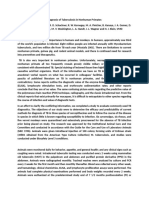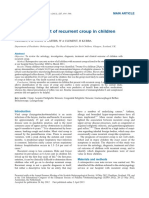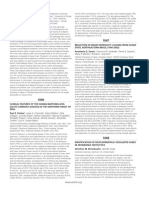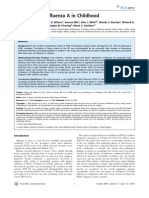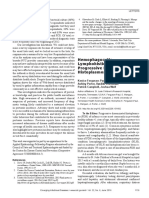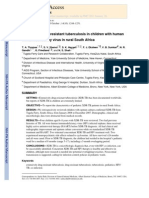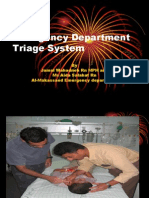Belize Histo
Belize Histo
Uploaded by
Elizabeth DarcyCopyright:
Available Formats
Belize Histo
Belize Histo
Uploaded by
Elizabeth DarcyOriginal Title
Copyright
Available Formats
Share this document
Did you find this document useful?
Is this content inappropriate?
Copyright:
Available Formats
Belize Histo
Belize Histo
Uploaded by
Elizabeth DarcyCopyright:
Available Formats
BRIEF COMMUNICATION
Outbreak of Histoplasmosis in a School Party That Visited a Cave in Belize: Role of Antigen Testing in Diagnosis
Jane A. Buxton, Meenakshi Dawar, L. Joseph Wheat,William A. Black, Nelson G.Ames, Marcella Mugford, and David M. Patrick
Histoplasmosis is endemic in parts of South and Central America and the role of bat guano is widely recognized in promoting the growth of the organism.1,2 Previous outbreaks have been reported among cavers in the United States3,4 and South America,5 often in travelers upon return to their home country. The illness may be quite severe, as the exposure is often extensive, emphasizing the importance of recognition of the risk for histoplasmosis in cavers and understanding the approach to diagnosis. Thirteen students (aged 16 to18 years) and 2 teachers from a school in Trail, British Columbia, Canada, traveled in Belize with 2 guides (1 Canadian, 1 from Belize) from March 16 to 26, 2000. Local BC physicians reported complaints of fever and chills in returning travelers to the BC Centre for Disease Control (BCCDC).
Jane A. Buxton, MBBS, MHSc, FRCPC: Federal Field Epidemiology Training Program, Laboratory Centre for Disease Control, Health Canada, Ottawa, ON, Canada; Meenakshi Dawar, MD MHSc, FRCPC: Department of Health Care and Epidemiology, University of British Columbia, Vancouver, BC, Canada; L. Joseph Wheat, MD: Histoplasmosis Reference Laboratory, Indiana University School of Medicine, Indianapolis, IN, USA; William A. Black, MBChB, FRCPC:The Provincial Laboratory, British Columbia Centre for Disease Control Society, Vancouver, BC, Canada; Nelson G. Ames, MD, MHSc, and Marcella Mugford, RN: Kootney Boundary Health Services, BC, Canada; David M. Patrick, MD, MHSc, FRCPC: Epidemiology Services, British Columbia Centre for Disease Control Society, Vancouver, BC, Canada. The histoplasma antigen testing was supported by a Merit Review Grant from the Department of Veterans Affairs. The authors had no financial or other conflicts of interest to disclose. Reprint requests: David M. Patrick, MD, MHSc, FRCPC, Epidemiology Services, British Columbia Centre for Disease Control Society, 655 West 12th Avenue, Vancouver, BC, Canada V5Z 4R4. J Travel Med 2002; 9:4850.
48
Method Two physicians from BCCDC flew to Trail on April 12, 2000 to investigate the outbreak. Information collected by local public health staff, available chest x-rays, and laboratory results were reviewed. Trip and symptom details were obtained from one of the teachers. A standard questionnaire, aimed to identify potential risk factors and symptoms, was developed. The questionnaire was administered, and blood and urine samples were obtained, at the high school on April 13. An enzyme-linked immunoassay (EIA) was used to detect histoplasma antigen in serum and urine; and has been previously described.6 Results, expressed as enzyme immunoassay units, of 1 unit or higher are regarded as positive. On May 25, a second questionnaire to determine symptom duration was administered at the school and convalescent serology and urine samples obtained. Telephone follow up of those reporting persisting symptoms was attempted. Results Sixteen initial questionnaires were completed; all 13 students (one by telephone); both teachers and the Canadian guide who faxed his response. No contact was possible with the guide from Belize. The prime focus of the trip involved salt water kayaking between islands and camping on the beaches. On March 18, all students, staff, and both guides had a 3-hour excursion into a cave where bats were present. At times, headroom was limited so the party crawled on the dry cave floor in bat guano.
Illness Profile
Fourteen individuals reported being ill following their return to Canada (attack rate of 87.5%); one student and the Canadian guide remained well. The symptom onset dates were April 29 (days 1522 post bat cave exposure); Figure 1. All who were unwell complained of headaches, chills, sweats, and muscle aches (mainly of the
B u x t o n e t a l . , H i s t o p l a s m o s i s i n a S ch o o l Pa r t y C a v i n g i n B e l i z e
49
additional individual (who was positive for urine antigen in April) had both M and H antibody to histoplasma.Thus, overall 7 of the 15 student/teacher-group tested positive for histoplasma antigen (4), antibody (2), or both (1). No specimens were available from the Canadian guide.
Chest X-ray Results
Figure 1 Reported date of histoplasmosis illness onset by students, teachers, and guide who visited a cave in Belize; (2 asymptomatic, n = 14).
back and neck), which were generally worse later in the day. Twelve persons reported a fever; most felt unusually tired and light-headed, and 9 reported joint symptoms. Although not noted as a major complaint at the initial public health nurse interviews, reported respiratory symptoms were common: 11 had shortness of breath; 10 had chest pains; 8 a sore throat; and 8 had a cough. Other symptoms reported were nausea (5 persons); abdominal pain (6); swollen lymph nodes (2); no rashes or other skin complaints were reported or seen. By April 13, 9 individuals had seen a physician since their return to Canada; 7 reported improvement in their symptoms; 3 reported no improvement; and 4 reported symptoms were worse. Fifteen follow-up questionnaires, 14 convalescent urine, and 10 convalescent serum specimens were obtained. Of the 14 questionnaire respondents who had been ill, 10 reported feeling completely better, and 4 were improving. Follow up of these 4 was attempted; 1 reported symptoms lasting 60 days but contact with the other 3 has not been possible. Ten (71%) of those who fell ill, experienced symptoms attributed to histoplasmosis lasting 1827 days; 4 (29%) were ill for more than 50 days.
Laboratory Results
Four cases had chest x-rays performed:1 was reported as normal; 1 showed a well-defined nodule of the left upper lobe; the third had patchy basal infiltrate but no pulmonary nodularity; a fourth demonstrated a faint nodule in the right upper lobe, which had resolved on a follow-up chest x-ray. The acute and convalescent urine antigen tests of the student with a well-defined nodule were negative (unfortunately no convalescent serum was available for antibody testing); however, this student reported debilitating symptoms continuing for 3 months after exposure so was given an oral antifungal regimen (itraconazole 200 mg bid for 6 weeks) with marked improvement in symptoms. Discussion Histoplasma capsulatum, a spore producing dimorphic fungus, is endemic through much of the world including the United States and Central and South America. The role of bird and bat guano is widely recognized in promoting the growth of the organism in soil by providing a source of nitrates, which accelerate spore formation.1,2 Bats, unlike birds, may themselves become infected with H. capsulatum. The severity of illness after inhalation exposure to H. capsulatum depends on the intensity of exposure and the immunity of the host. Most patients who acquire histoplasmosis remain asymptomatic, the only sign of a past exposure being a positive intradermal histoplasmin test. Inapparent infections are very common in endemic areas and usually result in increased resistance to infection. Heavy exposure can cause severe diffuse pulmonary infection. Treatment is not usually indicated because the illness is self limited and associated with minimal morbidity. Therapy may be helpful in symptomatic patients whose conditions have not improved during the first month of infection. Fever persisting for >3 weeks may indicate development of progressive disseminated disease, which may be aborted by therapy.7 Only one of the students who visited Belize required an oral antifungal regimen with marked improvement of their symptoms. This study shows the potential role of antigen testing for diagnosis of acute histoplasmosis.6,8 Antigen was detected in the urine of 5 of 7 subjects tested within the first month of exposure, for a sensitivity of 71% in acute histoplasmosis. Similar findings were observed in a study by one of the authors (LJW) during an outbreak in a
Thick and thin smears for malaria, spirochetes and trypanosomes, dengue serology, histoplasma antibody and antigen tests on all 10 serum samples obtained on day 26 post bat cave exposure were negative. Seven urine samples, also obtained within a month of exposure, were tested for histoplasmsa antigen: 5 were positive; 2 were negative (1 of these was from the asymptomatic student). Urinary antigen was not detected in follow-up urine specimens from 14 travelers. Convalescent serum specimens (> 2 months postexposure) were available for 10 travelers: 2 were positive for M antibody to histoplasma (both students had not provided urine samples in April); 1
50
J o u r n a l o f Tr a v e l M e d i c i n e , Vo l u m e 9 , N u m b e r 1
prison; antigenuria was detected in 20 of 24 (83%) prisoners. None of those who caved in Belize exhibited antigenemia, showing the greater sensitivity of urine testing in acute histoplasmosis. Other studies have shown the serologic response to be poor in the first month after exposure.9 The sensitivity of antigen detection is lower in patients with subacute pulmonary histoplasmosis (about 30%) or chronic pulmonary histoplasmosis (15%).8 Thus urine antigen testing is most useful for patients with acute presentations following exposure to a site suspected to be contaminated with H. capsulatum or with diffuse pulmonary infiltrates. Urine testing also should be performed in persons presenting within a month of presumed exposure to identify cases before the development of antibodies. Antigen testing may permit a rapid (1 day turn-around-time) diagnosis in such cases. In other studies, 7580% of subjects exhibited an antibody response, supporting the need for convalescent antibody testing.9,10 However, antibodies were detected in only 3 of 10 (30%) convalescent sera from the Belize cavers. Possible explanations for this discrepancy include differences in sensitivity of the testing methods (complement fixation tests are more sensitive than the immunodiffusion technique used in this study), timing of specimens, or intensity of exposure. H. capsulatum has not been known to cause illness in BC, but it is not a reportable disease. All 25 histoplasmin skin tests performed as part of an illness survey of students with respiratory symptoms in northern BC were negative.11 Fewer years of caving experience, longer time spent in the caves, and entering a confined crawl space have been found to be risk factors for histoplasmosis illness.3 The high attack rate of histoplamsosis of the Belize travelers (87.5%) is remarkably consistent with that found in a group of university students who entered a cave inhabited by bats in Costa Rica (88%).12 H. capsulatum has been more readily isolated from caves under dry conditions.13 The high attack rate of the Belize travelers may possibly be attributed to a number of factors: the young age of the travelers, lack of previous exposure, and the large inoculum of spores to which they were exposed crawling in the dry bat guano on the cave floor. In summary, this report emphasizes the risk for histoplasmosis among cavers. The risk of acquiring histoplasmosis must be considered by any tour operator or traveler contemplating cave exploration in Central or South America; outbreaks have occurred among individuals exploring caves in the United States,3 including caves outside the endemic area.4,14 Health care providers should include histoplasmosis in their differential diagnoses of travelers to endemic areas complaining of fever and chills and ask about cave exposure. We have also demonstrated the potential usefulness of urine antigen testing and the
limitations of serologic testing for diagnosis of acute histoplasmosis. Acknowledgment The authors would like to acknowledge the travelers, their school, and their physicians for their cooperation and help; staff of The Kootney Boundary Community Health Services Society for their assistance; and The Reference Laboratory in Edmonton for histoplasma antibody testing. References
1. Hoff GL, Bigler WJ. The role of bats in the propagation and spread of histoplasmosis: a review. J Wildlife Dis 1981; 17:191195. 2. McMurray DN, Russell LH. Contribution of bats to the maintenance of Histoplasma capsulatum in a cave microfocus. Am J Trop Med Hyg 1982; 31:527531. 3. Ashford DA, Hajjeh RA, Kelley MF, et al. Outbreak of histoplasmosis among cavers attending the National Speleological Society Annual Convention, Texas, 1994. Am J Trop Med Hyg 1999; 60:899903. 4. Sacks JJ, Ajello L, Crockett LK. An outbreak and review of cave-associated histoplasmosis capsulati. J Med Vet Mycol 1986; 24:313327. 5. Johnson J, Kabler MF, Gourley MF, et al. Cave-associated histoplasmosis: Costa Rica. MMWR 1988; 37:312313. 6. Durkin MM, Connolly PA, Wheat LJ. Comparison of radioimmunoassay and enzyme-linked immunoassay methods for detection of Histoplasma capsulatum var. capsulatum antigen. J Clin Microbiol 1997; 35:22522255. 7. Wheat J, Sarosi G, McKinsey D, et al. Practice guidelines for the management of patients with histoplasmosis. Clin Infect Dis 2000; 30:688695. 8. Williams B, Fojtasek M, Connolly-Stringfield P, Wheat J. Diagnosis of histoplasmosis by antigen detection during an outbreak in Indianapolis, IN. Arch Pathol Lab Med 1994; 118:12051208. 9. Davies SF. Serodiagnosis of histoplasmosis. Sem Resp Infect 1986; 1:915. 10. Larrabee WF, Ajello L, Kaufman L. An epidemic of histoplasmosis on the isthmus of Panama. Am J Trop Med Hyg 1978; 27:281285. 11. Illness Survey, School District 57, Prince George. Report prepared by the Department of Health Care and Epidemiology, University of British Columbia and the Faculty of Health and Human Sciences, University of Northern BC, Vancouver, BC, 1995. 12. International notes, cave associated histoplasmosis Costa Rica. MMWR 1988; 37:312313. 13. Disalvo AF, Bigler WJ, Ajello L, et al. Bat and soil studies for sources of histoplasmosis in Florida. Public Health Rep 1970; 85:10631069. 14. Ajello L, Palmer J, Winkler WG. Isolation of Histoplasma capsulatum from Arizona bats. Am J Epidemiol 1968; 89:606614.
You might also like
- Proof Service Dog Letter From Doctor PDFDocument2 pagesProof Service Dog Letter From Doctor PDFMariya ButchekNo ratings yet
- Case Study RubricDocument3 pagesCase Study RubricHazem Almasry100% (1)
- J Infect Dis. 2012 Bresee Infdis Jis206Document8 pagesJ Infect Dis. 2012 Bresee Infdis Jis206Letmar Yair InfanteNo ratings yet
- Recent SeparationDocument6 pagesRecent SeparationEl Karmo SanNo ratings yet
- NEJMoa2206704 HepatitisDocument9 pagesNEJMoa2206704 HepatitisMmmm GmNo ratings yet
- Morbidityand Mortality Weeklyreport: Epidem Iologic Notes and ReportsDocument16 pagesMorbidityand Mortality Weeklyreport: Epidem Iologic Notes and Reportsbuilderc08No ratings yet
- Acute Histologic Chorioamnionitis at Term: Nearly Always NoninfectiousDocument7 pagesAcute Histologic Chorioamnionitis at Term: Nearly Always NoninfectiousSri AgustinaNo ratings yet
- Hernia Diafragma PDFDocument4 pagesHernia Diafragma PDFEndang Rahayu Fuji LestaryNo ratings yet
- Case StudiesDocument30 pagesCase Studiessiachen260% (1)
- Ovadia 2007Document7 pagesOvadia 2007uditNo ratings yet
- Paniculitis Nodular Esteril en PerrosDocument10 pagesPaniculitis Nodular Esteril en PerrosMoisés RodríguezNo ratings yet
- Case 36-2004: A 23-Day-Old Infant With Hypospadias and Failure To ThriveDocument8 pagesCase 36-2004: A 23-Day-Old Infant With Hypospadias and Failure To ThriveGaniahUtamiNo ratings yet
- Module 6 - Case Study Exercise Gastroenteritis at A College: Learning ObjectivesDocument9 pagesModule 6 - Case Study Exercise Gastroenteritis at A College: Learning ObjectivesdlsajdlkasNo ratings yet
- Human Brucellosis: John M. Sauret, MD, and Natalia Vilissova, MDDocument6 pagesHuman Brucellosis: John M. Sauret, MD, and Natalia Vilissova, MDAndika Budi KurniantoNo ratings yet
- DiagnosisDocument3 pagesDiagnosisyusriantihanikeNo ratings yet
- Journal Reading AnakDocument19 pagesJournal Reading AnakPutra Priambodo WibowoNo ratings yet
- Leprosy in Pregnant Woman PDFDocument3 pagesLeprosy in Pregnant Woman PDFners_ivonNo ratings yet
- CroupDocument7 pagesCroupnadiaNo ratings yet
- Dodsworth Increased Incidence of Neonatal Respiratory Distress in Infants With Mucopolysaccharidosis Type II (MPS II, Hunter Syndrome)Document2 pagesDodsworth Increased Incidence of Neonatal Respiratory Distress in Infants With Mucopolysaccharidosis Type II (MPS II, Hunter Syndrome)BoNo ratings yet
- Outbreak Investigation Case Scenarios-PHASE III-SDL, 15-17.05.2023-1Document13 pagesOutbreak Investigation Case Scenarios-PHASE III-SDL, 15-17.05.2023-1srinidhi premkumarNo ratings yet
- Neonatal Group A Streptococcus Meningitis. Case Report and Literature ReviewDocument6 pagesNeonatal Group A Streptococcus Meningitis. Case Report and Literature ReviewJessyMomoNo ratings yet
- Jurnal ParotitissDocument2 pagesJurnal ParotitissmarcelinaNo ratings yet
- Junal PyodermaDocument6 pagesJunal PyodermaJares Clinton Saragih SimarmataNo ratings yet
- Acute Schistosomiasis: Report On Five Singular CasesDocument5 pagesAcute Schistosomiasis: Report On Five Singular Casesapi-318749549No ratings yet
- Pulmonary Tuberculosis As A Differential Diagnosis of PneumoniaDocument18 pagesPulmonary Tuberculosis As A Differential Diagnosis of PneumoniaKadek AyuNo ratings yet
- Archpedi 138 10 004Document4 pagesArchpedi 138 10 004Anonymous bBGvTixmNo ratings yet
- Ileal-Lymphoid-Nodular Hyperplasia, Non-Specific Colitis, and Pervasive Developmental Disorder in ChildrenDocument11 pagesIleal-Lymphoid-Nodular Hyperplasia, Non-Specific Colitis, and Pervasive Developmental Disorder in ChildrenEmmanuelLeidiNo ratings yet
- Led Nar 1985Document8 pagesLed Nar 1985Ioana AntonesiNo ratings yet
- Characterization of Children With Recurrent Episodes of Stevens Johnson SyndromeDocument17 pagesCharacterization of Children With Recurrent Episodes of Stevens Johnson SyndromeIndah AulliaNo ratings yet
- Johne's Disease and Crohn's Disease, Report in BriefDocument2 pagesJohne's Disease and Crohn's Disease, Report in BriefNational Academies of Science, Engineering, and MedicineNo ratings yet
- Clinical Course of Acute Infection of The Upper Respiratory Tract in Children: Cohort StudyDocument2 pagesClinical Course of Acute Infection of The Upper Respiratory Tract in Children: Cohort StudySeptian Sapta HadiNo ratings yet
- Medical Conference: Crohn DiseaseDocument9 pagesMedical Conference: Crohn DiseasetiaraNo ratings yet
- Pages 300-331Document31 pagesPages 300-331aptureinc100% (13)
- Case 10-2009: A 23-Year-Old Woman With An Abnormal Papanicolaou SmearDocument8 pagesCase 10-2009: A 23-Year-Old Woman With An Abnormal Papanicolaou SmearBulborea MihaelaNo ratings yet
- Mithal2020 PDFDocument11 pagesMithal2020 PDFLee제노No ratings yet
- Public Health Reports 1919Document35 pagesPublic Health Reports 1919Dark Heineken100% (1)
- Benign Familial HematuriaDocument6 pagesBenign Familial Hematuriasiska_mariannaNo ratings yet
- Journal InfluenzaDocument6 pagesJournal InfluenzaAzzie NiazieNo ratings yet
- Absceso Hepático NeonatalDocument6 pagesAbsceso Hepático NeonatalNabila Peña ZapataNo ratings yet
- tmp5FA4 TMPDocument4 pagestmp5FA4 TMPFrontiersNo ratings yet
- Public H-Ealth Reports: To Transmit Influenza ExperimentallyDocument4 pagesPublic H-Ealth Reports: To Transmit Influenza ExperimentallyRafiamNo ratings yet
- Pathologic Quiz Case: Residents' PageDocument4 pagesPathologic Quiz Case: Residents' Pagejeka222No ratings yet
- 365 FullDocument9 pages365 FullEzra SarmientoNo ratings yet
- The Streptococcus Pyogenes Carrier State - Judith Martin, MD1Document13 pagesThe Streptococcus Pyogenes Carrier State - Judith Martin, MD1cbtext1sNo ratings yet
- AteneoDocument8 pagesAteneofabiandionisioNo ratings yet
- Hemophagocytic Lymphohistiocytosis and Progressive Disseminated HistoplasmosisDocument3 pagesHemophagocytic Lymphohistiocytosis and Progressive Disseminated HistoplasmosisJohny SimatupangNo ratings yet
- Pamantasan NG Lungsod NG Maynila College of Medicine Depatment of Microbiology and Parasitology Case Discussion in Virology CASE No.1: Group 1Document2 pagesPamantasan NG Lungsod NG Maynila College of Medicine Depatment of Microbiology and Parasitology Case Discussion in Virology CASE No.1: Group 1Maikka IlaganNo ratings yet
- JPCC 2380 0534 01 0002 PDFDocument4 pagesJPCC 2380 0534 01 0002 PDFLuiggi D. Chambi MaidaNo ratings yet
- Extensively Drug-Resistant Tuberculosis in Children With HumanDocument12 pagesExtensively Drug-Resistant Tuberculosis in Children With Humanromeoenny4154No ratings yet
- Rge y LaringomalaciaDocument10 pagesRge y LaringomalaciamarisolpaulinaNo ratings yet
- Archpedi 1965 02090030368003 PDFDocument18 pagesArchpedi 1965 02090030368003 PDFMagha PokemongoNo ratings yet
- Midterm 604Document12 pagesMidterm 604JoshMatthewsNo ratings yet
- DiskusiDocument6 pagesDiskusiMeliana SulistioNo ratings yet
- Should We Treat Blastocystis Sp. A Double BlindDocument8 pagesShould We Treat Blastocystis Sp. A Double BlindDavid A. Osorio G.No ratings yet
- Epidemiological Study of Clinical and Laboratory Profiles of Patients Woth ALL at DR SoetomoDocument5 pagesEpidemiological Study of Clinical and Laboratory Profiles of Patients Woth ALL at DR SoetomoJulia Intan Permata SariNo ratings yet
- Epidemiology DLL Peritonsil Abses PDFDocument7 pagesEpidemiology DLL Peritonsil Abses PDFdamaiswariNo ratings yet
- Nguyen Minh Tuan 2013Document8 pagesNguyen Minh Tuan 2013libremdNo ratings yet
- CMV - Cazuri CliniceDocument5 pagesCMV - Cazuri CliniceMinerva StanciuNo ratings yet
- Worksheet - Causal Arguments (Edited S1 2023)Document8 pagesWorksheet - Causal Arguments (Edited S1 2023)danielNo ratings yet
- Investigation of A Dysentery Outbreak at A Psychiatric Rehabilitation Institution in Shilin District, Taipei City, 1997Document7 pagesInvestigation of A Dysentery Outbreak at A Psychiatric Rehabilitation Institution in Shilin District, Taipei City, 1997OktaPuspitaNo ratings yet
- Mock Papers for MRCPI, 3rd Edition: Four Mock Tests With 400 BOFsFrom EverandMock Papers for MRCPI, 3rd Edition: Four Mock Tests With 400 BOFsNo ratings yet
- Rongchao Lu Resume Tamu MbaDocument1 pageRongchao Lu Resume Tamu Mbaapi-335468161No ratings yet
- Certification Candidate HandbookDocument32 pagesCertification Candidate HandbookCao Minh TríNo ratings yet
- Ashleigh Resume 2016Document2 pagesAshleigh Resume 2016api-355193947No ratings yet
- SR No Hospital Score CityDocument2 pagesSR No Hospital Score CitySME FuturesNo ratings yet
- Cerj Sarigumba - Nurse's Progress Notes Fdar TemplateDocument2 pagesCerj Sarigumba - Nurse's Progress Notes Fdar TemplateCerj SarigumbaNo ratings yet
- (Osborn) Chapter 3 Learning Objectives (Number and Title)Document31 pages(Osborn) Chapter 3 Learning Objectives (Number and Title)KittiesNo ratings yet
- Motivational InterviewingDocument13 pagesMotivational Interviewingapi-548625849No ratings yet
- TriageDocument27 pagesTriageDanette Mae RocNo ratings yet
- Research Fifty (50) Bed Level 1 Government General Hospital: College of ArchitectureDocument29 pagesResearch Fifty (50) Bed Level 1 Government General Hospital: College of ArchitectureGerardo, Liano Ezekiel N.No ratings yet
- Emily C. Bair, MS, MPH, RD: ContactDocument1 pageEmily C. Bair, MS, MPH, RD: Contactapi-381876451No ratings yet
- Community Sexual and Reproductive Health TrainingDocument63 pagesCommunity Sexual and Reproductive Health TrainingSesan OnasanyaNo ratings yet
- Case Study and Research On EMDR For Combat PTSDDocument21 pagesCase Study and Research On EMDR For Combat PTSDDaniel R. Gaita, MA, LMSWNo ratings yet
- De Los Reyes-Sas 8Document2 pagesDe Los Reyes-Sas 8mmattyordoNo ratings yet
- SW Provider Directory 2018 1ST QTR - CompressedDocument20 pagesSW Provider Directory 2018 1ST QTR - CompressedStayWell InsuranceNo ratings yet
- Eb Harp February Aidsreg2019Document7 pagesEb Harp February Aidsreg2019Prince AshannaNo ratings yet
- C010 - Bm-Jahnvi Doshi - Research MethodologyDocument22 pagesC010 - Bm-Jahnvi Doshi - Research MethodologyJahnvi Doshi100% (1)
- UPND ManifestoDocument9 pagesUPND ManifestoJoseph Saidi Tembo100% (1)
- IV Decision AlgorithmDocument1 pageIV Decision AlgorithmsabirNo ratings yet
- Operational Plan 2017 - 2020: East Metropolitan Health ServiceDocument12 pagesOperational Plan 2017 - 2020: East Metropolitan Health ServiceAhmed M. RafatNo ratings yet
- HSSE-D-003 - Health ManagementDocument6 pagesHSSE-D-003 - Health ManagementAHMED AMIRANo ratings yet
- Torres AbstractDocument1 pageTorres AbstractEyana RomanNo ratings yet
- Pregnancy With Epilepsy TOACSDocument4 pagesPregnancy With Epilepsy TOACSsherzadmahreeNo ratings yet
- Medical Examination For An Australian Visa: CostsDocument9 pagesMedical Examination For An Australian Visa: CostsKHAIRUL REDZUANNo ratings yet
- The 'S of CSW BillingDocument2 pagesThe 'S of CSW Billingmamatha mamtaNo ratings yet
- NHSLeadership Leadership Framework Clinical Leadership Competency Framework CLCFDocument67 pagesNHSLeadership Leadership Framework Clinical Leadership Competency Framework CLCFMansyahNo ratings yet
- Asking Your Question (PICO) - NursingDocument5 pagesAsking Your Question (PICO) - NursingBentaigaNo ratings yet
- Question Bank Clinical Pharmacy Sem VIII 1Document11 pagesQuestion Bank Clinical Pharmacy Sem VIII 1Akira Patil100% (1)
- Floor Dec 2009 ScheduleDocument22 pagesFloor Dec 2009 ScheduleKKMIN595No ratings yet














